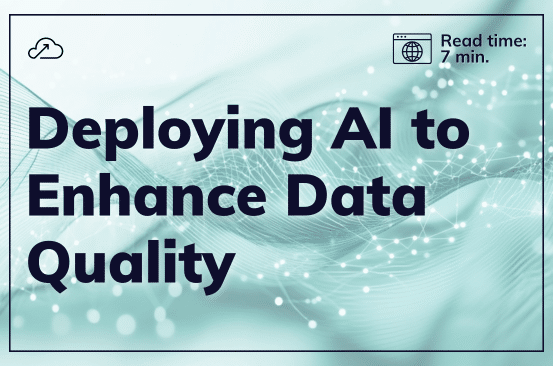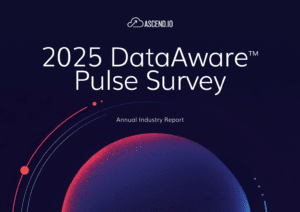AI-driven data quality workflows deploy machine learning to automate data cleansing, detect anomalies, and validate data. Integrating AI into data workflows ensures reliable data and enables smarter business decisions.
Data quality is the backbone of successful data engineering projects. Poor data quality can lead to costly errors, misinformed decisions, and ultimately, a significant economic impact. In fact, back in 2016, IBM reported that bad data costs the U.S. economy a staggering $3.1 trillion annually. We can only guess how much that number has grown in recent years. Poor data continues to undermine high-impact business projects, including AI implementation.
And yet, AI itself is a powerful tool for organizations to address poor data quality. AI offers innovative solutions to enhance data integrity, addressing long standing challenges faced by engineers. By automating data cleansing processes and providing predictive analytics, AI not only improves data accuracy but also ensures consistency and reliability.
In this blog post, we’re exploring the emerging role of AI in ensuring data is accurate, reliable, and insightful. Join us as we discuss 3 primary tools that engineers can leverage to ensure they deliver the gold standard in data.
The Role of AI in Enhancing Data Quality
Artificial Intelligence is rapidly becoming a cornerstone in the quest for superior data quality. By automating data cleansing processes, AI significantly enhances data accuracy and reduces errors, which are critical for engineering projects that rely on precise data inputs.
AI-driven data cleansing involves using machine learning algorithms to identify and correct inaccuracies in datasets. This process not only saves time but also ensures a higher level of data integrity compared to traditional manual methods. According to a McKinsey report, AI can reduce data processing errors by up to 50%, highlighting its potential to transform data quality management.
The integration of AI into data quality processes not only improves the reliability of data but also frees up valuable time for engineers to focus on more strategic tasks. As AI continues to evolve, its role in enhancing data quality will undoubtedly expand, offering even more sophisticated solutions to the challenges faced by data engineers today.
AI Tools to Ensure Data Quality
As data becomes increasingly central to business operations, ensuring its quality is more critical than ever. Traditional data quality management methods often fall short in handling the vast and complex datasets that modern organizations generate. AI-driven tools offer a more sophisticated approach, automating the detection and correction of data issues in real-time.
From anomaly detection and data cleansing to validation and enrichment, AI enhances data quality by embedding intelligence directly into data workflows. These advanced capabilities not only improve accuracy and reliability but also streamline processes, enabling teams to focus on higher-value tasks.
Here’s a closer look at 3 opportunities to implement AI to ensure data quality at scale.
AI-Integrated Data Pipelines
Embedding AI models directly into data workflows and data pipelines allows organizations to maintain data quality in near real-time, ensuring that data is clean, reliable, and ready for analysis at every stage of the data lifecycle. This approach integrates AI capabilities seamlessly within the data processing environment, enhancing automation and reducing manual oversight.
AI Models Commonly Embedded in Data Pipelines
- Machine Learning Models for Data Cleansing: These models can identify and correct errors, such as outliers or missing values, directly within the data pipeline. For instance, machine learning algorithms can impute missing data based on historical patterns, ensuring that the data is as complete and accurate as possible.
- Anomaly Detection Models: Embedding anomaly detection algorithms into pipelines allows for the automatic identification of data irregularities. For example, if a data point falls outside of expected ranges, the model can flag it or automatically adjust it based on predefined rules.
- Natural Language Processing (NLP) Models: NLP models embedded within workflows can clean and standardize unstructured text data by correcting spelling errors, normalizing terminology, and even translating data into a standard format required by downstream applications.
Implementing AI Models in Data Pipelines
- Model Integration into ETL Processes:
- Model Deployment: Deploy AI models within the ETL (Extract, Transform, Load) stages to clean, enrich, and validate data as it moves between sources and destinations. This setup ensures that the data loaded into analytics platforms is already vetted for quality.
- Model Deployment: Deploy AI models within the ETL (Extract, Transform, Load) stages to clean, enrich, and validate data as it moves between sources and destinations. This setup ensures that the data loaded into analytics platforms is already vetted for quality.
- Automated Feedback Loops:
- Adaptive Learning: Models embedded in data pipelines can learn from past corrections and adjustments, refining their algorithms to improve future performance. This creates a self-improving data quality system that gets smarter with more data.
- Error Tracking and Reporting: Integrate feedback mechanisms that log every detected issue, correction, and manual override, providing valuable insights for model retraining and pipeline optimization.
- Adaptive Learning: Models embedded in data pipelines can learn from past corrections and adjustments, refining their algorithms to improve future performance. This creates a self-improving data quality system that gets smarter with more data.
- Integrating AI Models with Data Orchestration Tools:
- Orchestration Platforms: Tools like Ascend can be configured to run AI models as part of the data pipeline, ensuring that quality checks are systematically executed at every stage.
- Conditional Workflows: Define conditions in workflows that trigger AI models based on data quality metrics, such as rerouting data that fails quality checks to specialized cleaning processes.
- Orchestration Platforms: Tools like Ascend can be configured to run AI models as part of the data pipeline, ensuring that quality checks are systematically executed at every stage.
Embedding AI models into data workflows and pipelines transforms data quality management from a reactive to a proactive practice, enhancing the overall data strategy. As organizations continue to embrace AI, embedding models into their data operations will become increasingly essential for maintaining high standards of data quality.
Watch and Learn: Check out an example of an AI-Integrated Data Pipeline
AI-Driven Predictive Analytics for Data Reliability
Using AI-driven predictive analytics enables organizations to anticipate potential data failures, allowing them to take proactive steps to enhance the reliability of their data systems. Here’s how predictive analytics can be effectively integrated into your data strategy:
Integrating Predictive Analytics into Your Data Systems
- Infrastructure Readiness: Ensure your existing data architecture can support the computational demands of AI models. This includes:
- Upgrading data storage and processing capabilities to handle large volumes of historical data.
- Implementing robust data integration tools that can seamlessly feed data into AI-driven analytics engines.
- Skill Development: Equip your data teams with the skills needed to interpret and act on predictive insights, including:
- Training in machine learning model evaluation and maintenance.
- Familiarity with data visualization tools to better understand the analytics output.
Key Benefits of AI-Driven Predictive Analytics
- Enhanced Data Reliability: Predictive analytics reduces unexpected data failures, minimizing downtime and improving overall system performance.
- Optimization of Data Management: Real-time insights into data health allow for the fine-tuning of data management processes, resulting in:
- Faster identification and resolution of data quality issues.
- More efficient use of resources through automation of routine maintenance tasks.
- Cost Reduction: By preventing outages and minimizing manual intervention, predictive analytics reduces operational costs and resource expenditures.
Leveraging Quarantined Data for AI-Driven Data Quality Improvements
Giving AI models access to quarantined data that has failed data quality checks allows organizations to better understand the root causes of data issues and address them directly at the source. This approach not only improves data quality but also enhances the overall effectiveness of AI-driven systems by refining the inputs they rely on.
Using Quarantined Data to Improve Data Quality
- Understanding Data Failures: When data is quarantined due to failing quality checks—such as missing values, format inconsistencies, or outliers—it’s often isolated from the main data flow to prevent contaminating analytics and operational processes. By granting AI models access to this quarantined data, organizations can gain valuable insights into why data is failing and how frequently these failures occur.
- Root Cause Analysis: AI models can analyze patterns within quarantined datasets to identify common sources of errors, such as faulty data feeds, recurring input errors, or systemic issues in data generation processes. This root cause analysis allows data engineers to implement targeted fixes, reducing the recurrence of similar quality issues.
- Enhanced Model Training: By exposing AI models to real-world examples of failed data, these models can learn to recognize and anticipate potential quality issues in live data streams, enhancing their predictive capabilities. This training helps models become more resilient and adaptive, improving their overall performance in maintaining data quality.
Implementing Quarantined Data Access in Data Workflows
- Controlled Environment for Analysis: Set up a controlled environment within the data pipeline where quarantined data can be safely accessed by AI models without impacting production data. This approach maintains data security and compliance while providing AI with the necessary information to perform quality assessments.
- Integration with Data Monitoring Systems: Connect AI models analyzing quarantined data with your existing data monitoring and alerting systems. This integration ensures that identified patterns and suggested improvements are automatically communicated to relevant stakeholders.
- Collaboration with Data Engineers: Encourage collaboration between AI models and data engineers by using the insights gained from quarantined data as a basis for joint problem-solving and process improvements. This partnership between AI and human expertise ensures that data quality issues are addressed comprehensively and effectively.
Overcoming AI-Implementation Challenges
Integrating AI into existing data systems presents a unique set of challenges that can significantly impact the success of AI projects. According to a Gartner report, 85% of AI projects fail to deliver value due to integration issues. This statistic underscores the importance of addressing these challenges head-on to ensure successful AI implementation.
Strategies for Successful AI Integration
- Align AI Tools with Business Objectives: Ensure that AI solutions are designed to complement existing workflows and directly support key business goals, rather than functioning as standalone projects.
- Build a Collaborative Culture: Effective AI integration requires close collaboration between data engineers, IT teams, and business stakeholders. Facilitating communication and cross-functional teamwork can bridge gaps between technical implementation and business needs.
- Invest in Scalable Data Infrastructure: Organizations must develop robust, scalable, and flexible data architectures that can support the evolving requirements of AI technologies, including advanced analytics and real-time data processing capabilities.
- Enhance System Interoperability: Leverage data integration platforms to enable seamless communication between AI models and existing systems, minimizing disruptions.
Conclusion
AI is transforming data quality and reliability in engineering by embedding intelligence directly into data workflows. Through automated cleansing, predictive analytics, and real-time anomaly detection, AI-driven solutions empower engineers to proactively manage data quality issues, enhancing accuracy and reducing errors. This proactive approach allows teams to shift focus from troubleshooting to strategic initiatives, driving greater efficiency and innovation. As AI technology continues to advance, its role in data engineering will expand, offering powerful tools to maintain high data standards and unlock new opportunities.
Now is the time to embrace AI-driven solutions in your data engineering practices. By investing in these technologies, you can enhance data quality, improve operational efficiency, and stay ahead as AI technology continues to advance.





